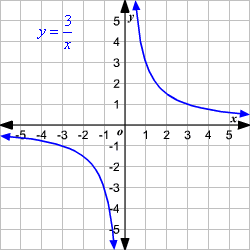Inverse Variation
While direct variation describes a linear relationship between two variables , inverse variation describes another kind of relationship.
For two quantities with inverse variation, as one quantity increases, the other quantity decreases.
For example, when you travel to a particular location, as your speed increases, the time it takes to arrive at that location decreases. When you decrease your speed, the time it takes to arrive at that location increases. So, the quantities are inversely proportional.
An inverse variation can be represented by the equation or .
That is, varies inversely as if there is some nonzero constant such that, or where .
Suppose varies inversely as such that or . That graph of this equation shown.

Since is a positive value, as the values of increase, the values of decrease.
Note: For direct variation equations, you say that varies directly as . For inverse variation equations, you say that varies inversely as .
Product Rule for Inverse Variation
If and are solutions of an inverse variation, then and .
Substitute for .
or
The equation is called the product rule for inverse variations.
Example:
In a factory, men can do the job in days. How many days it will take if men do the same job?
Here, when the man power increases, they will need less than days to complete the same job. So, this is an inverse variation.
Let be the number of men workers and let be the number of days to complete the work.
So, and .
By the product rule of inverse variation,
Solve for .
Therefore, men can do the same job in days.



